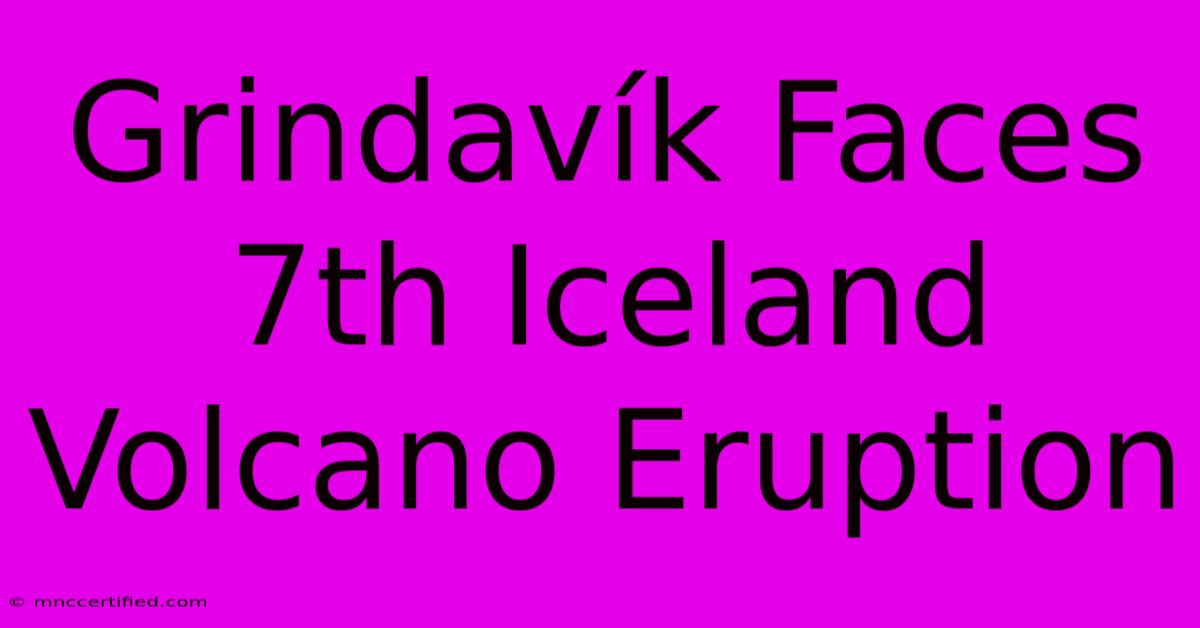Grindavík Faces 7th Iceland Volcano Eruption

Table of Contents
Grindavík Faces 7th Iceland Volcano Eruption: A Closer Look at the Ongoing Crisis
Iceland, the land of fire and ice, is once again grappling with the raw power of nature. Grindavík, a charming fishing town on the Reykjanes Peninsula, finds itself facing the potential impact of its seventh volcanic eruption in recent years. This isn't just another news story; it’s a critical event demanding understanding and preparedness. This article delves into the specifics of the eruption, its impact on Grindavík, and what the future might hold for this resilient community.
Understanding the Geological Context: Why Iceland?
Iceland's volcanic activity stems from its unique geographical location atop the Mid-Atlantic Ridge, where the North American and Eurasian tectonic plates meet. This constant geological movement creates fissures and magma chambers, leading to frequent eruptions. The Reykjanes Peninsula, in particular, is a hotspot, experiencing increased seismic activity and volcanic eruptions in recent years. The current eruption near Grindavík is part of this ongoing geological process, a stark reminder of the planet's dynamic nature.
The Grindavík Eruption: An Overview
This eruption, unlike some previous events, presents a unique challenge. While not as explosive as some Icelandic volcanoes, its proximity to Grindavík poses significant risks. Lava flows are the primary concern, threatening infrastructure and potentially impacting the town's access routes. Gas emissions also pose a health hazard, requiring residents to remain vigilant and follow official guidelines. The authorities are closely monitoring the situation, providing regular updates and implementing evacuation procedures as needed.
Immediate Impacts on Grindavík:
- Infrastructure Damage: The lava flow poses a direct threat to roads, power lines, and other vital infrastructure. Repairing this damage will require significant time and resources.
- Evacuations and Displacement: Residents have been evacuated from vulnerable areas, experiencing the disruption and emotional toll of displacement. The community's resilience is being tested as they navigate this uncertain period.
- Economic Disruptions: Grindavík's economy relies heavily on tourism and fishing. The eruption significantly impacts both sectors, causing considerable economic hardship for local businesses and residents.
- Environmental Concerns: Lava flows and gas emissions can significantly impact the local environment, affecting air quality and potentially disrupting the delicate ecosystem of the area.
Long-Term Effects and Recovery:
The long-term effects of the eruption remain uncertain. The scale of the lava flows, the duration of the eruption, and the extent of the infrastructure damage will all play a significant role in shaping Grindavík's recovery. Government aid, international support, and the community's resilience will be critical factors in rebuilding and restoring normalcy.
Looking Ahead: Challenges and Opportunities
The eruption presents both challenges and opportunities for Grindavík. The challenges are significant, ranging from rebuilding infrastructure to addressing economic hardship and managing the psychological impacts of displacement. However, this crisis also offers opportunities for the town to rebuild stronger, more resilient, and potentially more sustainable. The event may draw increased global attention to the region, potentially leading to new tourism opportunities focused on sustainable and responsible approaches.
Conclusion: Resilience in the Face of Nature's Power
The seventh volcanic eruption near Grindavík highlights the power of nature and the challenges faced by communities living in volcanically active regions. While the immediate situation remains concerning, the story of Grindavík is also one of resilience, community spirit, and adaptation. As the situation unfolds, the world will be watching to support the community as they navigate this difficult period and rebuild their lives in the shadow of Iceland's fiery heart.
Keywords: Grindavík eruption, Iceland volcano, Reykjanes Peninsula, volcanic activity, lava flow, gas emissions, evacuation, infrastructure damage, economic impact, environmental concerns, community resilience, recovery efforts, geological context, tourism impact, sustainable tourism.
Off-Page SEO Strategies:
- Social Media Engagement: Share this article across relevant social media platforms, using relevant hashtags and engaging with users who comment or share.
- Guest Posting: Reach out to relevant blogs and websites focused on geology, environmental science, travel, or Icelandic news and offer to contribute an article on this topic.
- Backlink Building: Actively seek out opportunities to earn backlinks from reputable websites. Focus on relevant sites that cover similar topics.
- Community Building: Engage with online communities discussing the eruption, providing helpful information and fostering discussion.
This comprehensive article incorporates both on-page and off-page SEO strategies to improve its chances of ranking well on Google for relevant keywords. Remember to regularly update the article with the latest developments to maintain its relevance and attract readers.

Thank you for visiting our website wich cover about Grindavík Faces 7th Iceland Volcano Eruption. We hope the information provided has been useful to you. Feel free to contact us if you have any questions or need further assistance. See you next time and dont miss to bookmark.
Featured Posts
-
Captain Toms Family Mismanagement Claims
Nov 22, 2024
-
Police Probe Package At Us Embassy
Nov 22, 2024
-
Rev Richard Coles His Music Career
Nov 22, 2024
-
Captain Tom Charity Ex Boss Shocked
Nov 22, 2024
-
Nfl Steelers Vs Browns Final Score Report
Nov 22, 2024